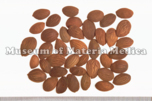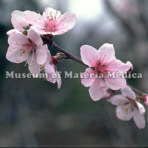Peach Kernel

|
Market name:桃仁 Photo location:Museum of Materia Medica, Inst. of Nat. Med. TMPW No.:10931 |

|
Plant name:Prunus persica Photo location:Tokyo, Japan Photo date:1984 Photographer:M. Mikage |
| Synonym | |
| Latin name | Persicae Semen |
| Botanical source: Family name | Rosaceae |
| Botanical source: Plant name | - Prunus persica Batsch (IPNI:1212858-2) - Prunus persica var. davidiana Maximowicz |
| Part used | Dried kernel of ripe seed |
| Empirical criteria for quality selection | Good one is enlarged. The cortex is brown and the inside is white in color. In general, the one without its cortex is good in quality (TN). |
| Constituents | Lipids: Oleic acid, Palmitic acid, Glyceride of stearic acid Triterpenoids: 24-Methylenecycloartanol, Δ7-Avenasterol, Citrostadienol Peptide: Emulsin Cyanogenic compounds: Amygdalin, Prunasin |
| Pharmacological effects | Raises skin temperature, antiallergic (water extract, alcohol extract). |
| Indications | As an antiinflammatory and for removing blood stasis, it is applied to treat a feeling of fullness and pain of hypogastric region, abdominal blood stasis, and irregular menstruation. The leaf of Prunus persica is widely used for abdominal pain and diarrhea in folk medicine. |
| Diseases | Amenorrhea, Menorrhalgia, Intra-abdominal tumor, Hyperemesis after childbirth, Lower abdominal pain, Swelling and pain due to contusion, Appendicitis, Constipation, Cough |
| Formulas | kyukichoketsuindaiichikagen , keishibukuryogan , keishibukuryoganryokayokuinin , kojito , goshitsusan , jiketsujunchoto , junchoto , jingyobofuto , sesshoin , senkinkeimeisan , sokeikakketsuto , daiobotampito , choyoto , teitoto , tokakujokito , toryuto , dokkatsuto , hachimisenkiho , hoyokangoto |
| Meridian tropism | Heart, Liver, Large intestine |
| Property | Neutral |
| Flavor | Bitter, Sweet |
| Classification in "Shen-non Ben-cao Jing" | Inferior |
| TCM: Classification | Drugs for regulating blood conditions |
| TCM: Medicinal effects | To promote blood circulation, to eliminate phlegm, and to relax the bowels. Used for amenorrhea, dysmenorrhea, mass formation in the abdomen, traumatic injuries, constipation. |
| Remarks | Listed in the Japanese Pharmacopoeia 18th ed. |
| References | TN: T. Namba & Y. Tsuda ed., Outline of Pharmacognosy, a Textbook, 3rd ed., Nankodo Co., Ltd., Tokyo, 1998. |
DNA sequences of medicinal plants
| Gene Region | |||||||||||||||||||
| Nuclear | Chloroplast | Mitochondria | |||||||||||||||||
| Botanical source: Plant name | 5Ss | 18S | ITS1 | 5.8S | ITS2 | 26S | others | trnH-psbA | matK | trnK | trnK-rps16 | trnT-L | trnL | trnL-F | rbcL | rpoC1 | ndhF | others | |
|
|
|||||||||||||||||||
|
|
AY179512
AY179513 AY179514 AY179515 AY179516 AY179517 AY179518 AY179519 AY179520 AY179521 AY179522 AY179523 AY179524 AY179525 AY179526 AY179527 AY179528 AY179529 AY179530 AY179531 AY179532 AY179533 AY179534 AY179535 AY179536 AY179537 AY179538 AY179539 AY179540 AY179541 AY179542 AY179543 AY179545 AY179544 AY179546 AY179547 AY179548 AY179549 AY179550 AY179551 AY179552 AY179553 AY179554 AY179555 AY179556 AY179557 AY179558 L28749 |
||||||||||||||||||
